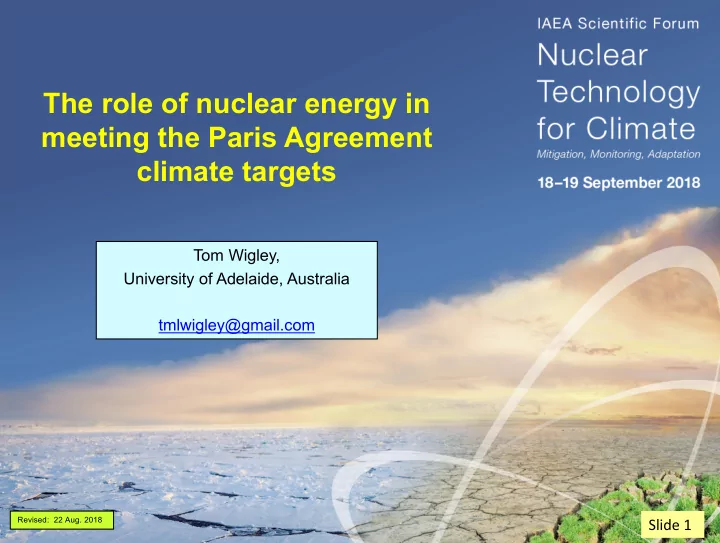

The role of nuclear energy in meeting the Paris Agreement climate targets Tom Wigley, University of Adelaide, Australia tmlwigley@gmail.com Slide 1 Revised: 22 Aug. 2018
PART 1: THE PARIS AGREEMENT Slide 2
PARIS AGREEMENT TARGETS Article 2.1: We must “(Hold) the increase in global average temperature to well below 2 ° C above pre-industrial levels and (pursue) efforts to limit the temperature increase to 1.5 ° C above pre-industrial levels …” PROBLEM: This precludes a warming overshoot. Without an overshoot, meeting the 2 ° C target will be much harder and meeting the 1.5 ° C would be virtually impossible. Article 4.1: “Parties aim to … achieve a balance between anthropogenic emissions by sources and removals by sinks of greenhouse gases in the second half of this century …” NOTE: This does not mean that emissions must drop to zero before 2100. PROBLEM: Articles 2.1 and 4.1 are potentially inconsistent. Slide 3
PARIS TARGETS: TEMPERATURES, EMISSIONS, CONCENTRATIONS TEMPERATURE:The arrow NOTES: Article 2.1 requires is the change from 1890- temperature stabilization, 1899 to 2013-2017 (1.023C; and Article 4.1 requires HadCRUT4 data) concentration stabilization before 2100. The 2.0C target case satisfies Article 4.1, but (because it involves a temperature overshoot), does not satisfy Article 2.1. For the 1.5C target, it is impossible to satisfy Article 4.1 (because concentration is not stabilized before 2100). The next slide elaborates Smoothed CO2 concentration on the temperature was 407 ppm in April 2018. overshoot issue. (See arrow.) Slide 4
PARIS TARGETS: IS OVERSHOOT UNAVOIDABLE? To answer this question I consider two impossible scenarios: reducing all emissions to zero either over 2020 to 2021 or 2020 to 2030. The results show that an overshoot is unavoidable for the 1.5C target . Slide 5
PART 2: THE ROLE OF NUCLEAR Slide 6
WHAT HAS BEEN DONE SO FAR? • Almost all countries have submitted Nationally Determined Contributions (NDCs) for actions to be taken over 2020 to 2030 towards meeting the 2.0C target. Actions are presented in terms of CO2-equivalent emissions reductions. • There are large uncertainties in defining/quantifying CO2-equivalent emissions (i.e., in how to combine the effects of emissions reductions in different gases). • When the NDCs are combined, the best estimate is that global CO2-equivalent emissions would continue to grow over 2010 to 2030 at a slightly lower rate than over 1990 to 2010. This is not good enough. For the 2.0C target a reduction in emissions is required. • Bottom line: nothing significant has been achieved so far. Slide 7
AN EXAMPLE THAT MEETS THE 2.0C TARGET The emissions reduction component breakdown here is derived using a cost- optimization algorithm This is a 2.0C case. Much larger increases in carbon-free energy components would be required to meet the 1.5C target. Slide 8
CONCLUDING COMMENTS • In policy-driven projections of future energy that are consistent with the 2.0C Paris target, my view is that the potential role for nuclear energy has been under-estimated. • For example, in some model simulations renewable energy costs are assumed to continue to decline, but nuclear energy costs are assumed to remain stable. • In addition, there are some influential scientists who are ideologically anti-nuclear, and the UNFCCC itself appears to show an anti-nuclear bias. • There is considerable scope for decentralized nuclear electricity generation using Small Modular Reactors, but progress on SMRs has been slow. • A strong future role for nuclear depends in part on large increases in electrification of the energy economy. Many model projections, however, show only slow growth in electrification. • Although meeting the 2.0C Paris target with relatively small growth of nuclear appears possible (as in the example I’ve given), it is likely that a much greater role for nuclear will be required to meet the 1.5C target. Slide 9
NOTES • Slide 3 : The noted “PROBLEMS” are based on results in Wigley, Climatic Change 147 , 31– 45 (2018). • Slide 4 : The results illustrated are from Wigley (2018). • Slide 5 : The rapid warming after 2020 is largely due to a reduction in the cooling effect of aerosols from SO2 emissions, which is a necessary consequence of the elimination of coal-based SO2 emissions. (See Wigley, Climatic Change 108 , 601–608, 2011). • Slide 7 : For further details see USAID, “Analysis of Intended Nationally Determined Contributions (INDCs)”, June 2016, https://www.climatelinks.org/projects/rali • Slide 8 : The information here is from US Climate Change Science Program Report 2.1a (Clarke et al., 2007). • Slide 9 : For further details on possible future expansion of the nuclear energy component, see Brook et al., Sustainability 2018 , 10 , 302. Slide 10
Recommend
More recommend